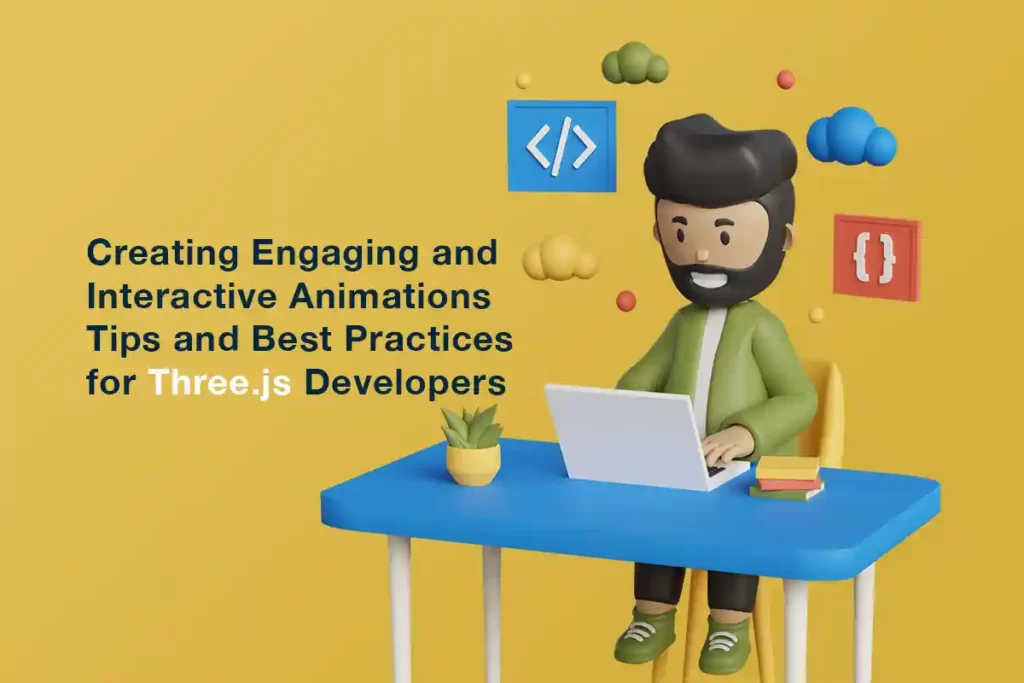Animation is a powerful tool in web development that can bring websites to life and create immersive user experiences. With the advancement of modern web technologies, creating animations has become easier and more accessible to developers. One popular JavaScript library for creating 3D animations on the web is Three.js.
Here are some time-tested tips shared by the top three.js developers to create engaging and interactive animations.
Plan Your Animation
Before diving into the coding process, first planning your animation is essential. This includes defining your animation’s purpose, goals, and target audience. Understanding the context and the story you want to tell with your animation is crucial. Planning your animation helps you create a cohesive and meaningful animation that resonates with your audience.
Optimize Performance
Performance is a critical factor in creating engaging animations. It’s essential to optimize the performance of your Three.js animations to ensure smooth and fluid motion.
Having too many objects can quickly degrade performance, especially if they are complex 3D models. Consider using techniques like level of detail (LOD) to dynamically reduce the complexity of objects not in the user’s view.
Another performance consideration is optimizing textures. Textures can consume a significant amount of GPU memory, so using them judiciously is important. Avoid using excessively large textures or too many textures in a single scene.
Additionally, consider using techniques like frustum culling to eliminate objects outside the camera’s view. This can reduce unnecessary rendering and improve performance.
Use Realistic Animations
Realistic animations can greatly enhance the user experience by creating a sense of immersion and interactivity. Three.js provides various animation techniques, such as tweening, skeletal animation, and morph targets, which can be used to create realistic animations.
- Tweening is another technique to give attention to. You can use tweening to animate properties such as position, rotation, and scale of objects in your scene. Three.js provides built-in tweening libraries like Tween.js that make creating smooth and natural animations easy.
- Skeletal animation is a technique that uses a hierarchical structure of bones to animate 3D models. It provides a way to animate complex characters or objects with articulated parts, such as robots or characters with joints. Three.js has a built-in SkinnedMesh class that allows you to create skeletal animations easily.
- Morph targets, also known as shape keys, are a technique that allows you to create animations by blending between different shape states of a 3D model. You can use morph targets to create facial expressions, character animations, or other deformations. Three.js provides the MorphTargets class, making creating morph target animations easy.
- When using realistic animations, focus on details such as timing, easing, and physics. Realistic animations should closely mimic the real-world behaviour of objects or characters, which can make your animations more engaging and visually appealing.
Add Interactivity
Interactivity is a key element of engaging animations. Adding interactivity to your Three.js animations can make them more immersive and allow users to participate in the experience actively.
You can add interactivity to your animations by incorporating user input, such as mouse or touch events, keyboard input, or device motion. You can use touch events to enable interactions on mobile devices, such as swiping or pinching to zoom.
In addition to user input, you can also create interactive animations by incorporating physics simulations. Three.js provides physics libraries like Cannon.js and Ammo.js that allow you to simulate realistic physics behaviours, such as gravity, collision detection, and rigid body dynamics. You can use physics simulations to create interactive games, simulations, or interactive experiences that respond to user actions.
Furthermore, you can leverage external libraries or APIs to add interactivity to your animations. For example, you can use APIs like the Web Audio API or the Web Speech API to create interactive audio or speech-controlled animations. You can also integrate external data sources, such as APIs for weather, social media, or real-time data, to create animations that dynamically respond to changing data.
When adding interactivity to your animations, be mindful of usability and accessibility. Ensure that your animations are intuitive and easy to interact with, regardless of the user’s input method or accessibility requirements. For visually impaired users, consider providing alternative ways to interact with your animations, such as keyboard navigation or text descriptions.
Pay Attention to Visual Design
Well-designed animations can capture users’ attention, evoke emotions, and convey meaning effectively. Consider the following visual design tips for your Three.js animations:
- Use visually appealing colours: Choose a colour palette that complements your animation’s theme and mood. Use colours strategically to draw attention to important elements, create visual contrast, and guide users’ focus.
- Utilize lighting and shadows: Lighting and shadows can greatly enhance your animations’ realism and visual depth. Experiment with different lighting techniques, such as ambient, directional, or point light, to create realistic and visually appealing scenes.
- Use appropriate textures and materials: Textures and materials can add visual interest and realism to your animations. Choose textures and materials that are appropriate for your scene and objects. For example, use metallic or glossy materials for reflective surfaces or rough or matte materials for realistic surfaces.
- Consider animations and transitions: Animations and transitions can add polish and smoothness to your animations. Use animations to transition between different states or views smoothly or to add subtle movements to objects. However, avoid overusing animations, as too many can become distracting and overwhelming.
Test and Iterate
Testing and iterating your animations are essential to ensure they are engaging and interactive. Pay attention to performance, interactivity, and visual design during testing.
Gather feedback from users, colleagues, or other stakeholders to identify areas for improvement. Consider conducting usability testing to understand how users interact with your animations and gather insights on areas needing improvement. Iterate your animations based on feedback and testing results to continuously improve their quality and effectiveness.
Ending Notes
Creating engaging and interactive animations with Three.js requires careful planning, optimization, attention to visual design, and interactivity. By following these practices, you can create immersive and captivating animations that provide an enjoyable user experience. Remember to plan your animation, optimize performance, use realistic animations, add interactivity, and pay attention to visual design.



